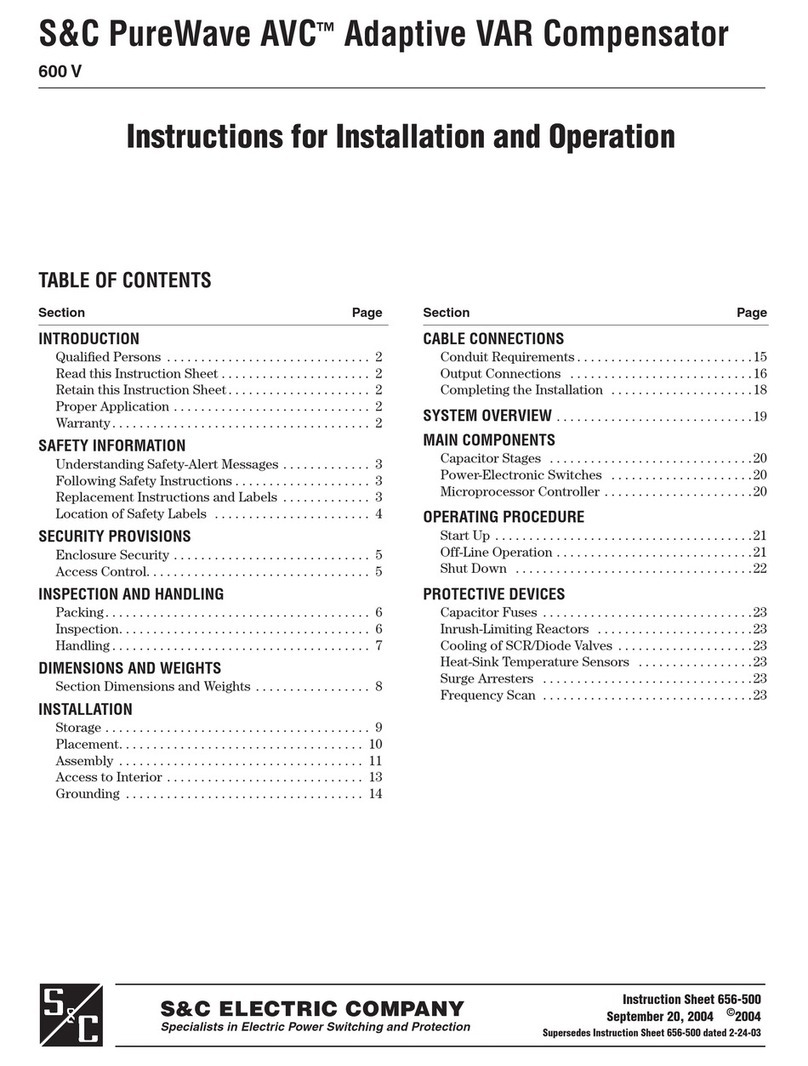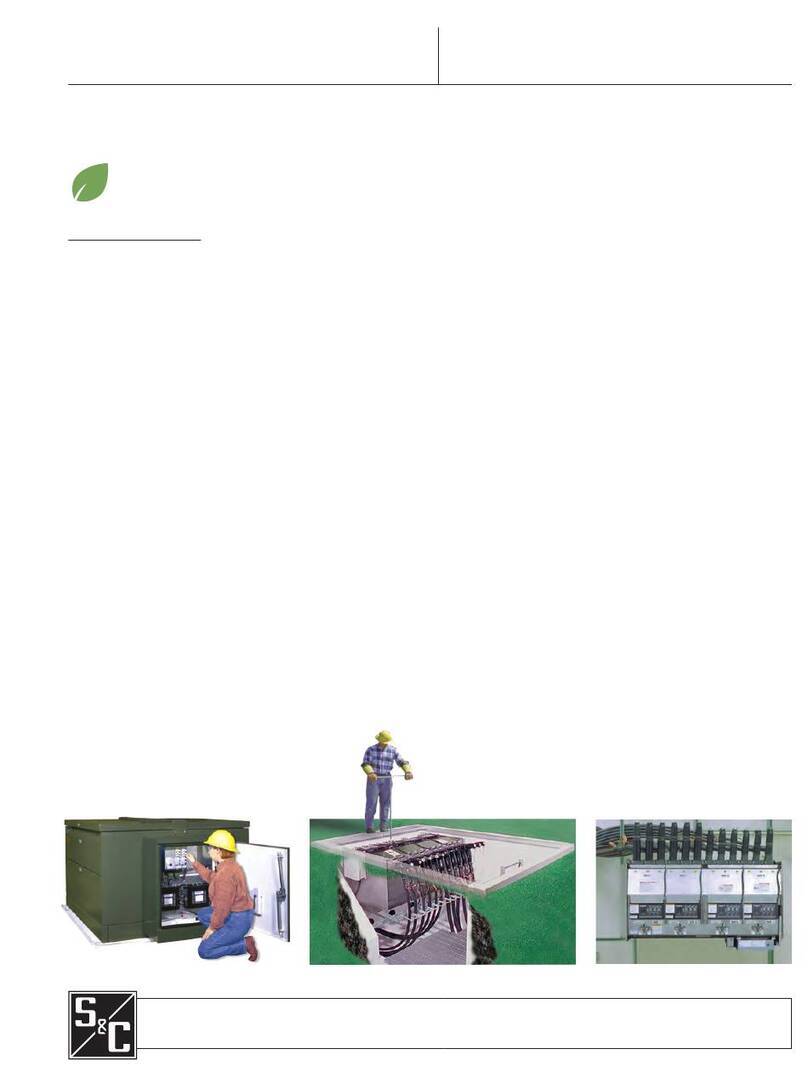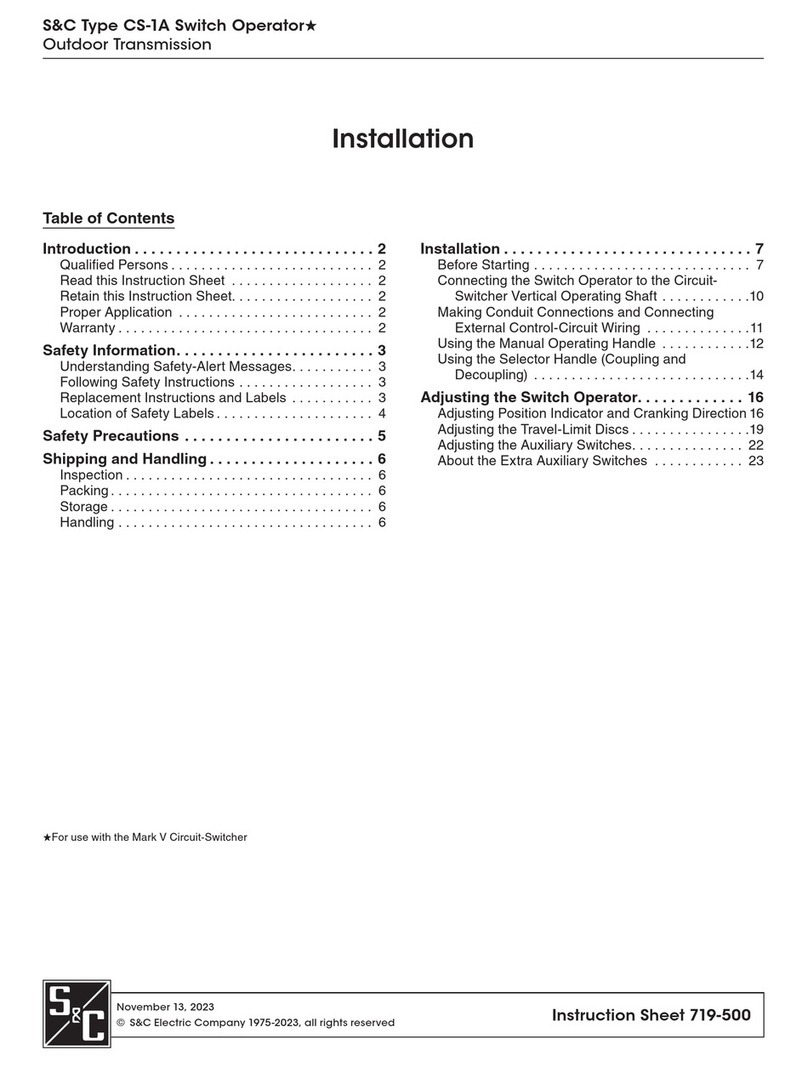S&C Mark V User manual

November 27, 2023
© S&C Electric Company 1976-2023, all rights reserved Instruction Sheet 711-590
Mark V Circuit-Switchers
Outdoor Transmission (34.5 kV through 345 kV)
Inspection Recommendations
Table of Contents
Introduction � � � � � � � � � � � � � � � � � � � � � � � � � � � � � 2
Qualified Persons � � � � � � � � � � � � � � � � � � � � � � � � � � � 2
Read this Instruction Sheet � � � � � � � � � � � � � � � � � � � 2
Retain this Instruction Sheet� � � � � � � � � � � � � � � � � � � 2
Proper Application � � � � � � � � � � � � � � � � � � � � � � � � � � 2
Special Warranty Provisions� � � � � � � � � � � � � � � � � � � 3
Warranty Qualifications � � � � � � � � � � � � � � � � � � � � � � 3
Safety Information� � � � � � � � � � � � � � � � � � � � � � � � 4
Understanding Safety-Alert Messages� � � � � � � � � � � 4
Following Safety Instructions � � � � � � � � � � � � � � � � � � 4
Replacement Instructions andLabels � � � � � � � � � � � 4
Safety Precautions � � � � � � � � � � � � � � � � � � � � � � � 5
Inspection Recommendations� � � � � � � � � � � � � � 6
Before Starting � � � � � � � � � � � � � � � � � � � � � � � � � � � � � 6
Recommended Inspection Schedule � � � � � � � � � � � 6
Recommended Inspection Procedures � � � � � � � � � � 9
Resistance Values � � � � � � � � � � � � � � � � � � � � � � � � � �10

2 S&C Instruction Sheet 711-590
WARNING
Only qualified persons who are knowledgeable in the installation, operation, and maintenance
of overhead and underground electric transmission and distribution equipment, along with
all associated hazards, may install, operate, and maintain the equipment covered by this
publication� A qualified person is someone who is trained and competent in:
• The skills and techniques necessary to distinguish exposed live parts from nonlive parts
of electrical equipment
•
The skills and techniques necessary to determine the proper approach distances
corresponding to the voltages to which the qualified person will be exposed
•
The proper use of special precautionary techniques, personal protective equipment, insulated
and shielding materials, and insulated tools for working on or near exposed energized parts
of electrical equipment
These instructions are intended only for such qualified persons� They are not intended to be a
substitute for adequate training and experience in safety procedures for this type ofequipment�
NOTICE
Thoroughly and carefully read this instruction sheet and all materials included in the product’s
instruction handbook before inspecting your Mark V Circuit Switcher� Become familiar with the
Safety Information and Safety Precautions on pages 4 and 5� The latest version of this publication is
available online in PDF format at https://www�sandc�com/en/contact-us/product-literature/�
This instruction sheet is a permanent part of the Mark V Circuit-Switcher. Store a copy in the
CS-1A Switch Operator’s instruction book holder, or designate a location where users can easily
retrieve and refer to this publication.
WARNING
The equipment in this publication is only intended for specific applications� The application
must be within the ratings furnished for the equipment� Ratings for the vertical-break style
Mark V Circuit-Switcher are listed in the ratings table in Specification Bulletin 711-31� The
ratings are also on the nameplate affixed to the product�
Qualified
Persons
Read this
Instruction
Sheet
Retain this
Instruction
Sheet
Proper
Application
Introduction

S&C Instruction Sheet 711-590 3
Introduction
The standard warranty contained in the seller’s standard conditions of sale, as set forth in Price
Sheet 150, applies to Mark V Circuit-Switchers and accessories and associated switch operators,
except the rst paragraph of the said warranty is replaced by the following:
(1) General: The seller warrants to the purchaser for a period of five years from the date of
shipment that the equipment delivered will be of the kind and quality specified in the contract
description and will be free of defects of workmanship and material. Should any failure to
conform to this warranty appear under proper and normal use within five years after the
date of shipment, the seller agrees, upon prompt notification thereof and confirmation that
the equipment has been stored, installed, operated, inspected, and maintained in accor-
dance with recommendations of the seller and standard industry practice, to correct the
nonconformity either by repairing any damaged or defective parts of the equipment or (at
the seller’s option) by shipment of necessary replacement parts. Replacement parts provided
by the seller under the warranty for the original equipment will be covered by the original-
equipment warranty for its duration.
Replacement parts purchased separately will be covered by the warranty contained in
the seller’s standard conditions of sale, as set forth in Price Sheet 150.
Warranty of circuit-switchers is contingent upon each of the following:
•
Observance of the static and dynamic deection limits shown on S&C Data Sheet 711-300,
711-301, 711-302, or 711-303, as applicable
• Power operation of circuit-switchers only by S&C Switch Operators
•
Installation and adjustment of circuit-switchers in accordance with S&C’s applicable erection
drawings and instruction sheets
• Conformance with the inspection recommendations dened in S&C Instruction Sheet 711-590
(this docu ment)
Special
Warranty
Provisions
Warranty
Qualifications

4 S&C Instruction Sheet 711-590
Several types of safety-alert messages may appear throughout this instruction sheet and on labels
and tags attached to the Mark V Circuit-Switcher. Become familiar with these types of messages
and the importance of these various signal words:
DANGER
“DANGER” identifies the most serious and immediate hazards that will likely result in serious
personal injury or death if instructions, including recommended precautions, are not followed�
WARNING
“WARNING” identifies hazards or unsafe practices that can result in serious personal injury
or death if instructions, including recommended precautions, are not followed�
CAUTION
“CAUTION” identifies hazards or unsafe practices that can result in minor personal injury if
instructions, including recommended precautions, are not followed�
NOTICE
“NOTICE” identifies important procedures or requirements that can result in product or property
damage if instructions are not followed�
If any portion of this instruction sheet is unclear and assistance is needed, contact the nearest S&C
Sales Ofce or S&C Authorized Distributor. Their telephone numbers are listed on S&C’s website
sandc.com, or call the S&C Global Support and Monitoring Center at 1-888-762-1100.
NOTICE
Read this instruction sheet thoroughly and carefully before inspecting
the Mark V Circuit-Switcher�
If additional copies of this instruction sheet are required, contact the nearest S&C Sales Ofce,
S&C Authorized Distributor, S&C Headquarters, or S&C Electric Canada Ltd.
It is important that any missing, damaged, or faded labels on the equipment be replaced immedi-
ately. Replacement labels are available by contacting the nearest S&C Sales Office, S&C Authorized
Distributor, S&C Headquarters, or S&C Electric Canada Ltd.
Understanding
Safety-Alert
Messages
Following
Safety
Instructions
Replacement
Instructions
andLabels
Safety Information

S&C Instruction Sheet 711-590 5
DANGER
Mark V Circuit-Switchers operate at high voltage� Failure to observe the
precautions below will result in serious personal injury or death�
Some of these precautions may differ from company operating procedures and rules�
Where a discrepancy exists, follow your company’s operating procedures and rules�
1�
QUALIFIED PERSONS� Access to Mark V Circuit-
Switchers must be restricted only to qualified
persons� See the “Qualified Persons” section on
page 2�
2�
SAFETY PROCEDURES� Always follow safe
operating procedures and rules�
3� PERSONAL PROTECTIVE EQUIPMENT� Always
use suitable protective equipment, such as rubber
gloves, rubber mats, hard hats, safety glasses, and
flash clothing, in accordance with safe operating
procedures and rules�
4�
SAFETY LABELS� Do not remove or obscure any of
the “DANGER,” “WARNING,” “CAUTION,” or
“NOTICE” labels�
5�
OPERATING MECHANISM AND BASE� Mark V
Circuit-Switchers contain fast-moving parts that
can severely injure fingers� Do not remove or
disassemble operating mechanisms or remove
access panels unless directed by S&C Electric
Company�
6�
ENERGIZED COMPONENTS� Always consider all
parts live until de-energized, tested, and grounded�
Voltage levels can be as high as the peak line-to-
ground voltage last applied to the unit� Units that
have been energized or installed near energized
lines should be considered live until tested and
grounded�
7� GROUNDING� The Mark V Circuit-Switcher must
be connected to a suitable earth ground at the base
of the utility pole, or to a suitable building ground
for testing, before energizing the switch and at all
times when energized�
8� The ground wire(s) must be bonded to the system
neutral, if present� If the system neutral is not
present, proper precautions must be taken to ensure
the local earth ground, or building ground, cannot
be severed or removed�
9�
SWITCH POSITION� Always confirm the Open/
Close position of each switch�
•
Switches and terminal pads may be energized
from either side�
•
Switches and terminal pads may be energized
with the switches in any position�
10�
MAINTAINING PROPER CLEARANCE� Always
maintain proper clearance from energized
components�
Safety Precautions

6 S&C Instruction Sheet 711-590
Inspection Recommendations
Before Starting
To ensure a Mark V Circuit-Switcher’s continued proper
performance, it should be inspected in accordance with
the recommended schedule and procedures contained
in this publication. Table 1 on pages 7 and 8 indicates
the frequency with which each major circuit-switcher
component should be inspected. Table 2 on pages 9 and
10 lists a summary of inspection procedures appropriate
for each component.
These inspection recommendations are applicable to
Mark V Circuit-Switcher models having one, two, or three
interrupting gaps per pole-unit.
Recommended Inspection Schedule
A mechanical-operations test value is indicated in Table 1
on pages 7 and 8 for those Mark V Circuit-Switcher compo-
nents affected by the number of mechanical operations
performed. It is a guideline to the number of Open/Close
operations expected for the component before replace-
ment is required.
Electrical operations limits are listed for the interrupter
and disconnect live parts because these components are
affected by the number of electrical operations performed.
These limits depend on the circuit-switcher application,
magnitude of current switched and, in some cases, the
style of circuit-switcher involved. For the interrupter and
disconnect live parts, the electrical operations limit may
provide a more accurate guideline for the number of Open/
Close operations expected before replacement is required.
The actual number of Open/Close operations for a
component will depend on the nature of the application,
the environment (e.g., whether subject to temperature
or humidity extremes or highly corrosive or dusty
atmospheres), and the observance of the recommended
inspection schedule.
An inspection frequency is shown for each component.
To maximize the operating life of the component, S&C
recommends the user perform the inspection procedures in
Table 1 on pages 7 and 8 at the frequency indicated by a “
●
”—
either in number of Open/Close operations or years, which-
ever occurs more often. If the inspection results indicate
or if dictated by the mechanical operations test value or
electrical operations limit guideline, the component should
be replaced.
Each user’s own experience will determine whether
more frequent inspections are required.
Note: For most transformer-protection applications, the
circuit-switcher inspection frequency is approximately
ve years, consistent with many utilities’ transformer-
inspection practices.

S&C Instruction Sheet 711-590 7
Inspection Recommendations
Table 1� Recommended Inspection Schedule for S&C Mark V Circuit-Switcher Components
Component
Mechanical-
Operations
Test Value①,
Number of
Open/Close
Operations
Electrical-Operations Limit Inspection Frequency②
Application
Maximum
Current,
Amperes
Circuit-
Switcher
Style
Number of
Open/Close
Operations
Number of Open/Close Operations Number
of Years
1 or 2 125 250 500 1 000 2
500 1 5
Switch
operator,
power train,
brain, and
shunt-trip
device
5 000 — — — — ●■ ●■
Interrupter 5 000
Capacitor,
reactor,
or load
switching
250
All
5 000 ●▲
●▲
550 2 000 ●▲
1 000 1 000 ●▲
Load
switching
1 200 All 750 ●▲
1 600
Center-break
500 ●▲
2 000 250 ●▲
Fault
interrupting
Secondary-
fault
interrupting
rating of
circuit-switcher
All 25
Not applicable
Primary-fault
interrupting
rating of
circuit-switcher
All 10
Disconnect
live parts 5 000
Capacitor,
reactor, or
load
switching
250
All 5 000■●◆
●
550 2 000■●◆
1 000
Vertical-break
and integer
with extra-
performance
closing
contacts
1 000■●◆
Vertical-break
and integer
without extra-
performance
closing
contacts
500■●◆
Center-break 1 000 ●
Load
switching
1 200
Vertical-break
and integer
with extra-
performance
closing
contacts
750■●◆
Vertical-break
and integer
without extra-
performance
closing
contacts
350■●◆
Center-break 750 ●
1 600
Center-break
500 ●
2 000 250 ●
Fault
closing
Fault-closing
rating of
circuit-switcher
All 2●Not
applicable
TABLE CONTINUED ▶

8 S&C Instruction Sheet 711-590
Inspection Recommendations
Table 1� Recommended Inspection Schedule for S&C Mark V Circuit-Switcher Components—Continued
Component
Mechanical-
Operations
Test
Value①,
Number of
Open/Close
Operations
Electrical-Operations Limit Inspection Frequency②
Application
Maximum
Current,
Amperes
Circuit-
Switcher
Style
Number of
Open/Close
Operations
Number of Open/Close Operations Number
of Years
1 or 2 125 250 500 1 000 2 500 1 5
Pre-insertion
inductor — — — — — ● ▼
Bypass
accessory — — — — —
Not applicable
●
Grounding
switch — — — — — ●
① Based on mechanical operations tests perform by S&C using a new
circuit-switcher with no intervening maintenance performed�
②
Frequently operated circuit-switchers (typically 200 or more Open/
Close operations a year) should be inspected after the first 250 opera-
tions� Thereafter, they should be inspected at the frequency indicated�
Frequently operated circuit-switchers also require annual lubrication of
the disconnect live parts� See Table 2 on pages 4 and 5�
●Recommended inspection frequency�
■Shunt-trip equipped 69-kV single-gap circuit-switchers in ungrounded
capacitor-switching applications must be inspected and the brains adjusted,
as necessary, every 1000 operations to prevent the occurrence of occa-
sional restrikes during opening operations� Non-shunt-trip equipped
69-kV single-gap circuit-switchers in ungrounded capacitor-switching
applications must be inspected and the brains adjusted, as necessary,
every 500 operations to prevent the occurrence of occasional restrikes
during opening operations� See S&C Instruction Sheet 711-515�
▲Interrupters should be checked for low gas pressure (red targets)
during the user’s normal day-to-day operating procedures�
◆
For vertical-break style and integer style circuit-switchers manufactured
before 1983, the electrical operations limit of the disconnect live parts is
approximately one-half of the value indicated because the closing contacts
on these circuit-switchers apply lower contact pressure� Consequently,
the recommended inspection frequency for the disconnect live parts of
these circuit-switchers, in number of Open/Close operations, is one-half
of the value indicated� Present-design closing contacts are available for
field retrofit; refer to the nearest S&C Sales Office�
▼Frequently operated circuit-switchers equipped with pre-insertion
inductors require annual cleaning of the inductor windings� See Table 2
on pages 9 and 10�

S&C Instruction Sheet 711-590 9
Inspection Recommendations
Recommended Inspection Procedures
The Mark V Circuit-Switcher inspection procedures to be
followed are summarized in Table 2. The applicable S&C
instruction sheets for the circuit-switcher, switch operator,
pre-insertion inductor, grounding switch, etc., should be
referenced for further details.
Table 2� Recommended Inspection Procedures for S&C Mark V Circuit-Switcher Components
Component Inspection Procedures
General
1� Check with the nearest S&C Sales Office to determine whether there are any outstanding field notifications involving inspection,
maintenance, or retrofit�
2� Check the overall cleanliness of the insulators, live parts, and exterior of the operator� If there is severe contamination, power wash
with water or clean using a non-abrasive cleaning method� After washing, reapply an appropriate contact lubricant,to the disconnect
live parts�①
Switch operator
1� Check for evidence of water ingress, damage, excessive corrosion, or wear�
2� Check the ease of operation during slow, manual cranking using the switch operator manual operating handle� Listen for
simultaneity of tripping of the interrupters� From the point at which one interrupter trips, no more than 40° of rotation should be
required before the other two interrupters trip� If excessive rotation is required, contact the nearest S&C Sales Office�
3� Simulate a fault by activating the protective relay circuit (if applicable)� Check electrical operation, coupled and decoupled�
4� Check for loose wiring inside the enclosure and proper functioning of the position-indicating lamps, operation counter, convenience
lamp, etc�
5� Check brake operation and adjust, if necessary�
6� Check the key interlocks, if furnished, mechanically and electrically�
Power train
1� Check for evidence of damage, excessive corrosion, or wear�
2� Check the fastener tightness�
3� Observe operation during slow, manual cranking using the switch operator manual operating handle� Check for complete stroking
of the various drive levers against their stops and for attainment of over toggle positions, as required�
4� Check seal conditions�
Brain
1� Remove the brain cover and check for evidence of water ingress, damage, excessive corrosion, or wear�
2� Check for tightness of shunt-cable fasteners and for evidence of excessive fraying of the shunt cable�
3� Check the seal conditions�
4� Replace the brain cover� Observe operation during slow, manual cranking using the switch operator manual operating handle�
Listen for the tripping action of the interrupter on opening and observe operation of the interrupter targets�
5� Check for proper clearances at the brain adjustment-holding device and at the blade crank-arm stop�
Shunt-trip device
1� Remove the shunt-trip solenoid-housing cover and check for evidence of water ingress, damage, excessive corrosion, or wear�
2� Check the seal conditions�
3� Replace the shunt-trip solenoid-housing cover� Simulate a fault by activating the protective-relay circuit� Verify all three shunt-trip
solenoids function and the switch operator motor follows through to open the disconnect�
Interrupter
1� Check for low gas pressure (red indicator)�
2� Check the fastener tightness on current-carrying parts�
3� (Optional) Check the resistance using the resistance values in Table 3 on page 11 for a vertical-break or integer style circuit-switcher
or Table 4 on page12 for a center-break style circuit-switcher�

10 S&C Instruction Sheet 711-590
Inspection Recommendations
Table 2� Recommended Inspection Procedures for S&C Mark V Circuit-Switcher Components—Continued
Component Inspection Procedures
Disconnect
live parts
1� Check for evidence of damage, excessive corrosion, or wear—especially at the fault-closing contacts and current-carrying contacts�
Replace current-carrying jaw contacts if the silver-alloy inserts on two or more contact fingers are worn to the extent the blade
tongue contact engages the full width of the contact finger�
2� Check the fastener tightness on current-carrying parts�
3� Observe operation during slow, manual cranking using the switch operator manual operating handle� Check for proper contact
alignment�
4� Lubricate the contact surfaces with an appropriate lubricant�①
Pre-insertion
inductor
1� Clean the exterior finish of inductor windings using a mild soap and water solution and a soft cloth� Inspect the fiberglass roving for
damage or wear� Use a mild soap and water solution and a clean cloth to clean the exterior finish of the inductor winding�While
cleaning the windings, inspect for damage or exposure of the fiberglass roving�
2� If the fiberglass roving is damaged, use the touch-up kit, S&C catalog number SA-42721, to refinish any damaged surfaces� First,
thoroughly wire-brush the surface to be refinished�Then, sand with No�1 sandpaper and No�0 sandpaper to create a smooth surface�
Brush on the paint according to the directions on the label and let dry for six hours� If the coiled conductor beneath the fiberglass
roving is exposed,remove the inductor from service and contact your nearest S&C Sales Office for a replacement.
3� Inspect the moving and stationary arcing rods to verify their proper setting� Replace the arcing rods if they show significant wear or
erosion�
Bypass
accessory
1� Check for evidence of damage, excessive corrosion, or wear�
2� Check the fastener tightness on current-carrying parts�
3� Observe operation using the stick-operated ratchet mechanism� Check for proper contact alignment�
4� Lubricate the contact surfaces with an appropriate lubricant�①
Grounding switch
1� Check for evidence of damage, excessive corrosion, or wear—especially at the jaw-contact members�
2� Check the fastener tightness on current-carrying parts�
3� Observe operation using manual operating handle� Check for proper contact alignment�
4� Lubricate the contact surfaces with an appropriate lubricant�①
①Shell Gadus® S2 U1000 2 Lubricant, catalog number 9999-043, is
available in 1 oz� tubes from S&C� Shell Darina SD2, Dow 33, or equivalent
can be substituted�
Resistance Values
The allowable resistance values indicated in Table 3 on
page 11 and Table 4 on page 12 are provided for the
convenience of users whose practices include measuring
and recording the resistance over current-carrying and
current-interrupting components of a circuit-switcher.
Such measurements are not required to fulll the terms
of S&C’s circuit-switcher warranty and should only be
made by qualied personnel fully trained in the measur-
ing equipment and the techniques for making resistance
measurements on high-voltage equipment. The measure-
ments can be used to identify areas of high resistance, to
be remedied by cleaning and maintenance, or component
replacement.

S&C Instruction Sheet 711-590 11
Inspection Recommendations
Table 3� Allowable Resistance Values for S&C Mark V Circuit-Switcher, Vertical-Break And Integer Styles
kV Gaps
Allowable Resistance
In Microhms, Between Points
In Megohms,
Between Points
2-3, Interrupter
Open
1-4●
2-3, Interrupter Closed
1-2 3-4 4-7■1-5 6-7
Continuous
Current Less
Than 400 A
Continuous
Current
Greater Than
400 A
34�5 130 600 200 15 15 130 40 40 –
46 130 600 200 15 15 140 40 40 –
69
1
30
600 200
15 15 160 40 40
–
21 000 333 208–312
115
1
30
600 200
15 15 220 40 40
–
21 000 333 208–312
138
1
30
600 200
15 15 230 40 40
–
21 000 333 208–312
31 500 500 312– 468
161
2
30
1 000 333
15 15 240 40 40
208–312
31 500 500 312– 468
DANGER
De-energize and ground the circuit-switcher at all six
terminals before making resistance measurements�
Follow all applicable safety procedures�
Failure to de-energize and ground the circuit-
switcher before making resistance measurements
can result in serious injury or death�
Interrupter
Measure the resistance between points2 and 3 with the inter-
rupter closed. If the measurement exceeds the allowable
value indicated, measure the resistance between points2
and 3 with the interrupter open. If that measurement exceeds
the allowable value indicated, replace the interrupter.
Now, measure the resistance between points1 and 4
with the interrupter closed. If the measurement exceeds the
allowable value indicated, measure the resistance between
points1 and 2, and then measure the resistance between
points3 and 4. If either of those measurements exceeds
the allowable value, disassemble the appropriate bolted
connection, clean the surfaces, reapply an appropriate
contact lubricant, and reassemble the connection.
Disconnect
Measure the resistance between points4 and 7 with
the interrupter closed. Subtract the value of resistance
measured between points2 and 3 with the interrupter
closed. If the difference exceeds the allowable value for
resistance between points 4 and 7, measure the resis-
tance between points6 and 7 and between points 1 and 5.
If either of those measurements exceeds the allowable
value, contact the nearest S&C Sales Ofce for assistance.
●
Resistance between points 1 and 4 minus the actual resistance between
points 2 and 3 with the interrupter closed�
■
Resistance between points 4 and 7 minus the actual resistance between
points 2 and 3 with the interrupter closed�
⑤
①
②
③
④⑥⑦

12 S&C Instruction Sheet 711-590
Inspection Recommendations
Table 4� Allowable Resistance Values For S&C Mark V Circuit-Switcher, Center-Break Style
kV
Cont�
Current,
Amperes
Gaps
Allowable Resistance
In Microhms, Between Points
In Megohms,
Between
Points 5-6,
Interrupter
Open
4-7●
5-6, Interrupter Closed
1-2 3-4 4-5 6-7 7-8■8-9
Continuous
Current
Less Than
400 A
Continuous
Current
Greater Than
400 A
230 1 600 330 1 500 500 30 30 15 15 165 30 312– 468
2 000 130
345 1 600 330 1 500 500 30 30 15 15 225 30 312– 468
2 000
⑤①
②
③
④
DANGER
De-energize and ground the circuit-switcher at all six
terminals before making resistance measurements�
Follow all applicable safety procedures�
Failure to de-energize and ground the circuit-
switcher before making resistance measurements
can result in serious injury or death�
Interrupter
Measure the resistance between points5 and 6 with the inter-
rupter closed. If the measurement exceeds the allowable
value indicated, measure the resistance between points5
and 6 with the interrupter open . If that measurement exceeds
the allowable value indicated, replace the interrupter.
Now, measure the resistance between points 4 and 7
with the interrupter closed. If the measurement exceeds the
allowable value indicated, measure the resistance between
points 4 and 5, and then measure the resistance between
points 6 and 7. If either of those measurements exceeds
the allowable value, disassemble the appropriate bolted
connection, clean the surfaces, reapply an appropriate
contact lubricant, and reassemble the connection.
Disconnect
Measure the resistance between points 7 and 8 with
the interrupter closed. Subtract the value of resistance
measured between points 5 and 6 with the interrupter
closed. If the difference exceeds the allowable value for
resistance between points7 and 8, measure the resistance
between points 8 and 9, between points1 and 2, and between
points 3 and 4. If any of those measurements exceeds the
allowable value, contact the nearest S&C Sales Ofce for
assistance.
●Resistance between points 4 and 7 minus the actual measured
resistance between points 5 and 6 with the interrupter closed�
■Resistance between points 7 and 8 minus the actual measured
resistance between points 5 and 6 with the interrupter closed�
⑥
⑦⑧
⑨
Other manuals for Mark V
2
Table of contents
Other S&C Industrial Equipment manuals
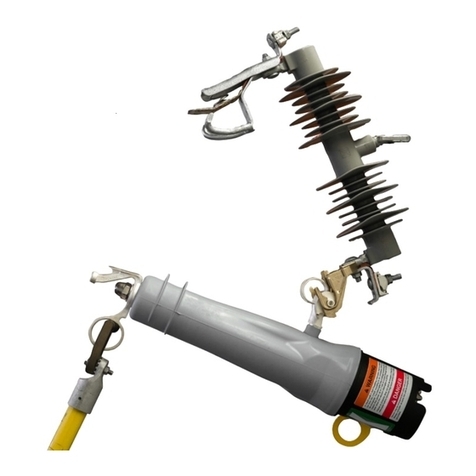
S&C
S&C VacuFuse II User manual
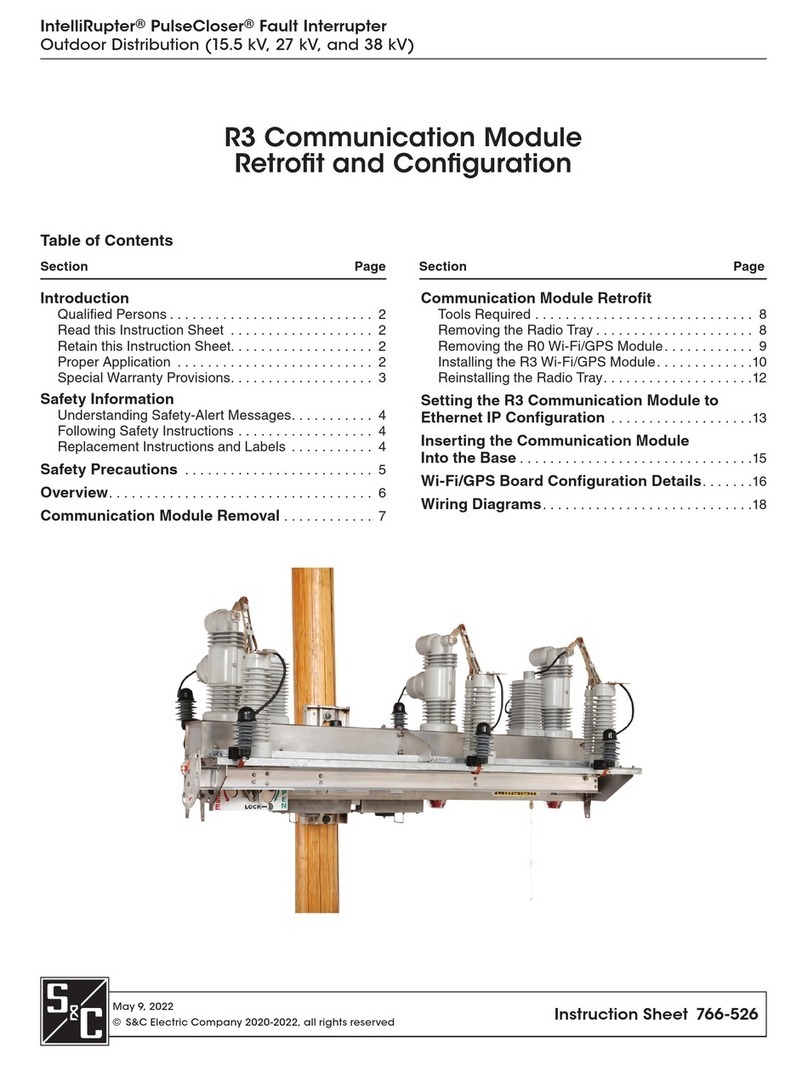
S&C
S&C IntelliRupter PulseCloser R3 User manual
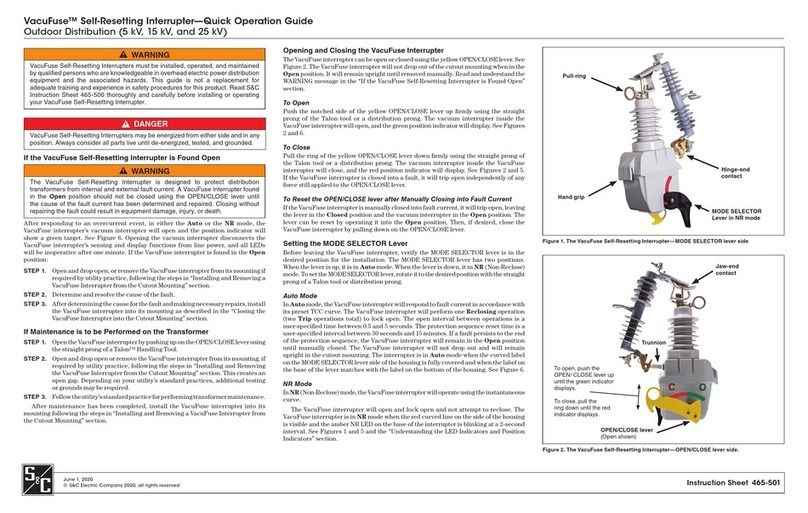
S&C
S&C VacuFuse User guide
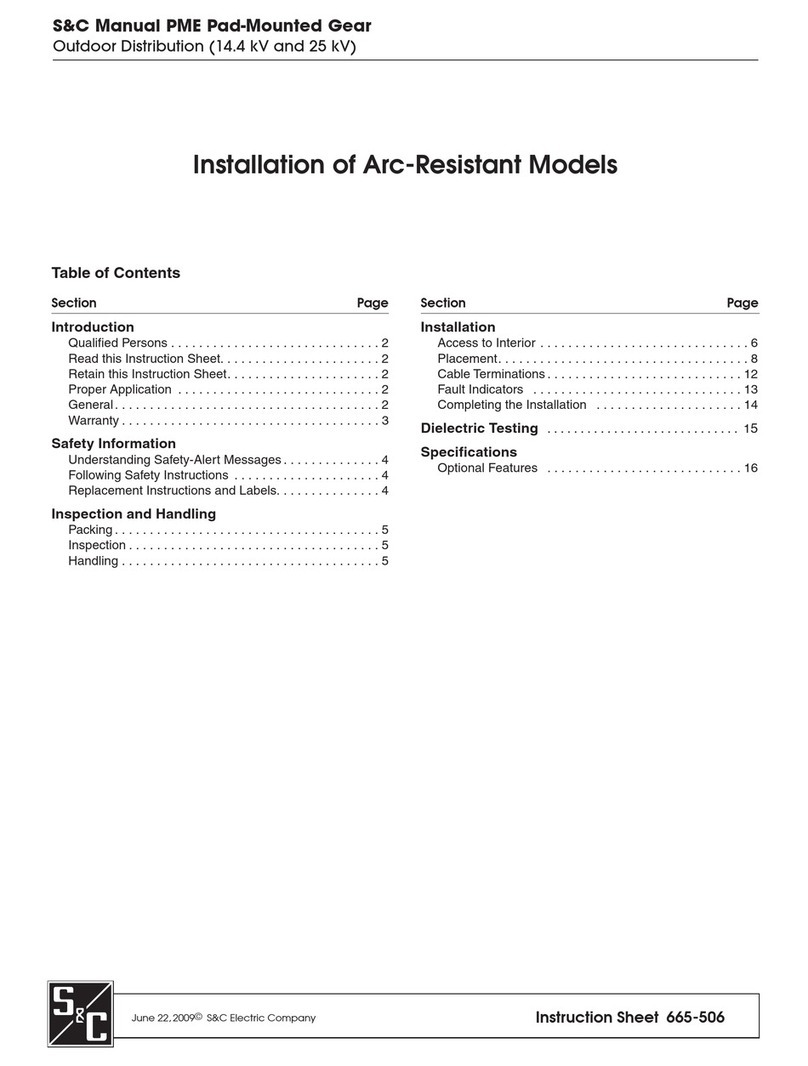
S&C
S&C PME Pad-Mounted Gear User manual
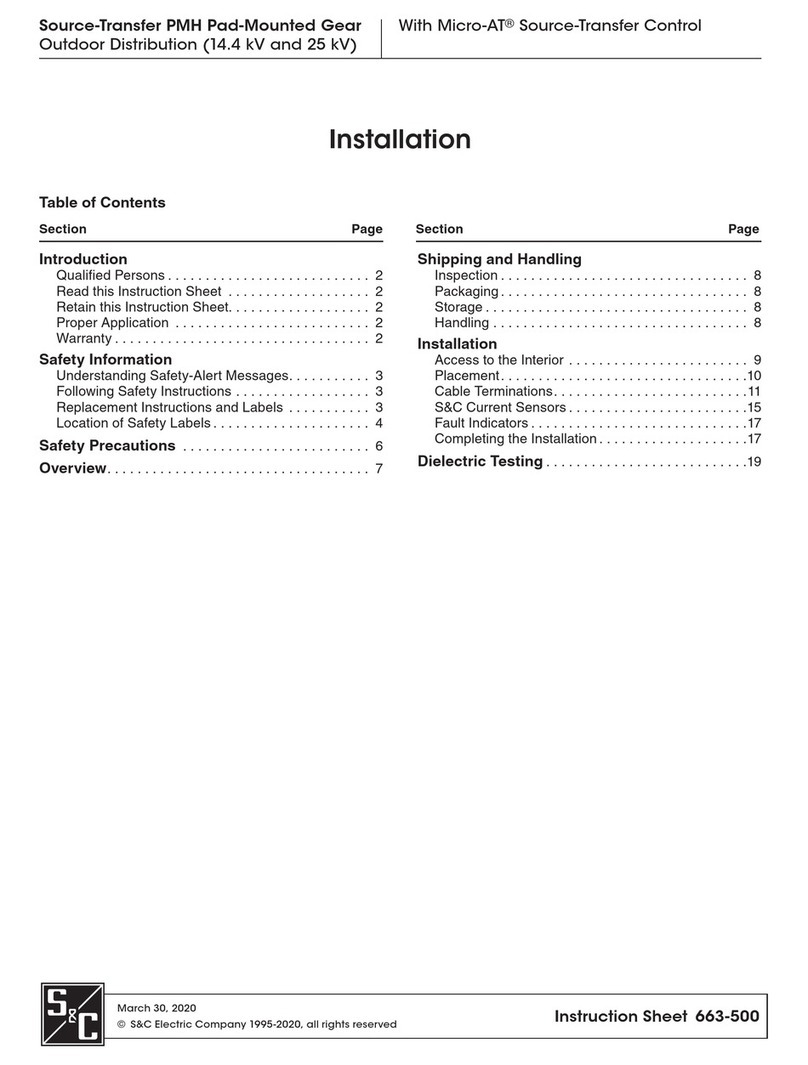
S&C
S&C PMH User manual

S&C
S&C VacuFuse II User guide
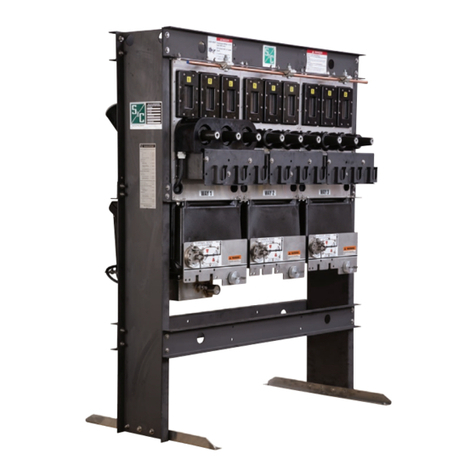
S&C
S&C Vista SD 101 User manual
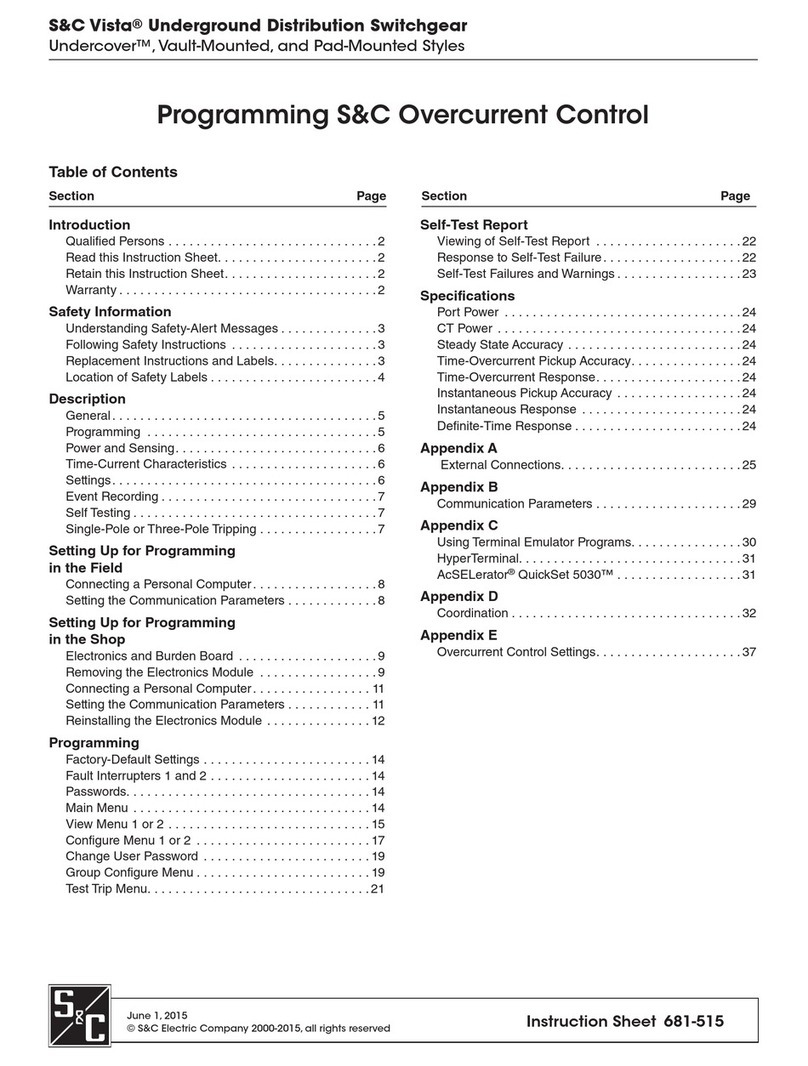
S&C
S&C Vista Owner's manual
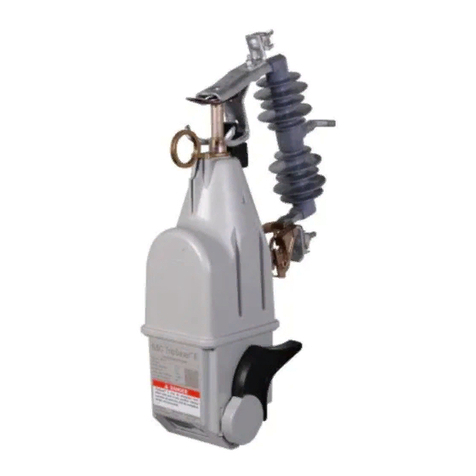
S&C
S&C TripSaver II User manual

S&C
S&C TripSaver II User manual

